Eggplant is a representative of the southern culture, so growing a vegetable in a cool climate is not so easy for him. We will try to reveal the most important issues of interest to gardeners on the topic: eggplant - growing and caring in the open ground.
Material Content:
- 1 Eggplant - varieties for open ground
- 2 Basic requirements for growing
- 3 Growing seedlings at home
- 4 How to plant eggplant in open ground
- 5 Outdoor Care
- 6 Features of growing in a greenhouse
- 7 The main problems associated with growing
- 8 Diseases, pests and methods of dealing with them
- 9 Eggplant collection and storage
Eggplant - varieties for open ground
In our climatic conditions, it is possible to grow a variety of eggplant varieties and their hybrids. Species for which you do not need to pre-grow seedlings have also become popular. In the open ground, experts still recommend planting seedlings, which allows you to postpone the ripening period of the fruits to a warmer summer period and increase yield.
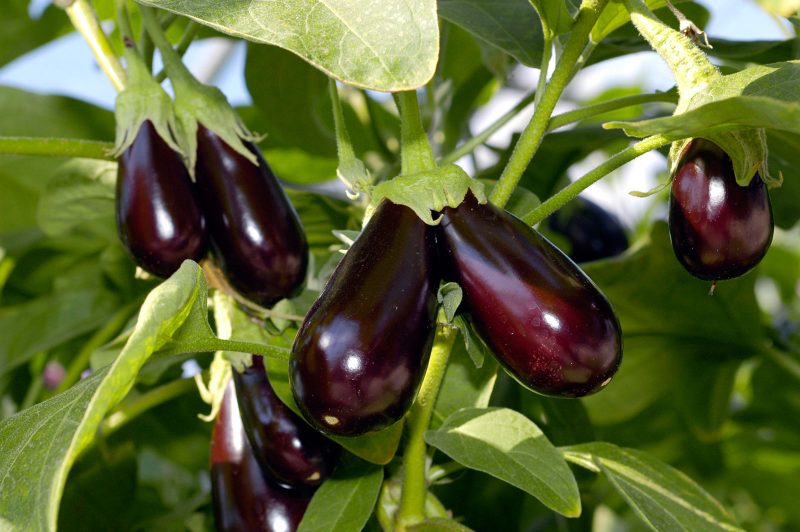
The yield, ripening speed, taste and resistance to disease are the qualities by which gardeners choose an eggplant variety for planting.
The most popular types of eggplant:
- Epic F1 - refers to the early varieties. Only 2 months and you can already harvest the first crop. It has good taste, high yield, little susceptible to disease.
- Albatross - long shelf life and taste without bitterness, the hallmarks of this type of eggplant. Ripening about 120 days. The average weight of a vegetable is 400 grams. Small-sized bushes free them from tying.
- Spherical variety - a branching bush up to 60 cm high. The first collection can be removed after 110-120 days. Many sufficiently large fruits ripen up to 300 g. Suitable for long transportation.
- Grade Diamond gained its popularity due to its resistance to temperature changes.
- Joker - differs in that in stable warm weather the first fruits ripen after only 85 days.
From many varieties of culture, each gardener chooses the most suitable variety for himself, focusing on the climatic characteristics of the region.
Basic requirements for growing
When growing eggplant, the main requirements include the following:
- selection of a vegetable variety;
- soil preparation;
- competent dressing during the growth of a seedling and ripening of the fetus;
- timely watering;
- weed treatment.
Growing seedlings at home
Before starting growing seedlings, it is necessary to select high-quality seeds from a trusted manufacturer.
Before sowing, seeds must be prepared. To do this, they are soaked in a low concentration manganese solution for 20-30 minutes. After processing, the seeds must be washed with water.

Sowing is carried out in a fertilized, loose soil with a low acidity index. Seedling pots are filled on ¾ with soil, the seeds are laid out and sprinkled on top with a small layer of earth, which is watered abundantly.
As soon as the seedlings appeared, the containers with seedlings should be placed in a cool place (16-18 degrees) with good lighting. After 7 days, the room temperature can be increased to 25 degrees.
It is recommended to water the seedlings in the morning, at room temperature. Watering should not be too plentiful to avoid leaching of seeds or damage to the root. Water should also be avoided on the leaves and stems of the plant.
To grow good seedlings, additional dressing is necessary. You can feed complex mineral fertilizers or bait, prepared at home. For these purposes, use a yeast solution, tincture of tea leaves or wood ash.
When 2 real leaflets grow, a dive procedure is carried out in a larger container. The first watering after transplantation is carried out after 6-7 days and then once a week.
How to plant eggplant in open ground
Eggplant is well received in fertile and fertilized soil. Therefore, when preparing the soil for planting, it is supplemented with mineral fertilizers and humus.
Plant eggplant seedlings in holes of 2 pcs., Pre-fill them with plenty of water. The distance between them depends on the selected variety. For bushes of low-branching and undersized keep a distance of 45 cm, for tall and lush - up to 60 cm. It is sufficient to place the roots of plants in the ground to a depth of 2 cm.
Planting eggplant in open ground should take place in early summer. But even during this period, there is a high probability of temperature changes, so young seedlings should be covered with a film for the night.
Outdoor Care

To get a good eggplant crop, it is not enough to grow seedlings and plant them in the beds. This requires proper and timely care.
Watering, fertilizing and fertilizing
Eggplants are hygrophilous plants; therefore, drying of the soil should not be allowed. Lack of moisture leads to falling leaves and fruits, growth is slowed down. Watering eggplant is carried out once a week, in hot weather - more often. Water should be warm. It needs to be poured exclusively under the root to prevent getting on the stem and leaves.
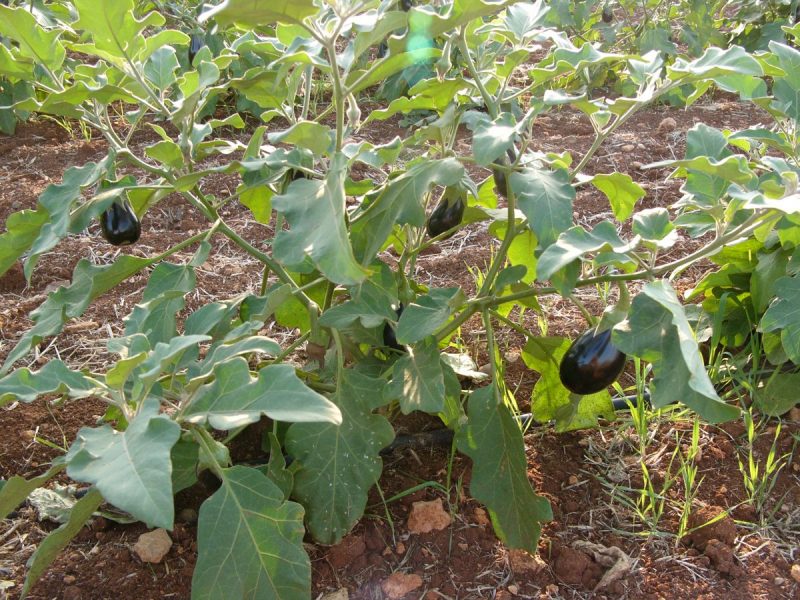
During the entire growth period, eggplant is carried out from 3 to 5 top dressings. The first - not earlier than 3 weeks after planting in the ground, because Until then, it will be useless. For plant nutrition, complexes of mineral origin are used (during the formation and growth of the stem and leaves), an aqueous solution of superphosphate and ammonium nitrate (for better setting and fruit growth), and organic fertilizers (to strengthen the stem).
In order not to get a beautiful and large bush without fruits, experts do not recommend the frequent use of organic top dressing.
All of these types of fertilizers are applied alternately. During the ripening period, the soil is sprinkled with ash. An aqueous solution of boric acid will help improve flowering. Solutions should not fall on the leaves and stalk, as may leave a burn.
Loosening and tying
An important process in the care of eggplant is loosening. After watering and top dressing, the soil can be covered with a crust, which prevents the penetration of air and its warming.
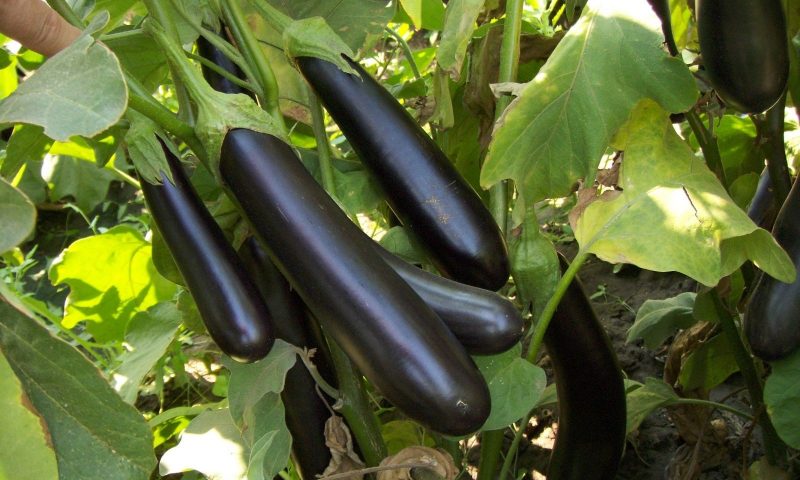
Loosen the earth is not deep, because the roots of the bushes are located close to the surface. After loosening, the plants grow up, which allows the root system to breathe better and the soil retains moisture longer. The process of loosening prevents the rapid emergence of weeds.
Tall eggplant varieties require a garter to prevent stem refraction. The tying is carried out when the bush reaches a height of 30 cm. The stem should not be tied too tight, because it will still increase in thickness and height.
Plant formation
The formation of eggplant bushes in importance in caring for a plant is on a par with watering and top dressing. There are no specific time limits for this procedure. It depends on the variety of vegetables and weather conditions. The formation of the bush begins with pinching its top, when it stretches up to 30-35 cm. Then the extra side shoots are removed, leaving only the largest ones. With ovary and flowers, they do the same. At the same time, the preserved large and strong ovary gets the opportunity to fully grow and develop, and all the excess does not draw strength from the plant. The main trunk is cleaned of the deciduous ring. On an bush, on average, there should be 8 eggplant fruits.
Proper formation results in a uniform distribution of nutrients throughout the plant. All these actions are recommended in the evening or morning hours.
How to pinch eggplant
For proper pinching, the following recommendations should be followed:
- manipulation is carried out without the use of a garden tool, as eggplant stalks are already quite fragile;
- You can start pinching in the third week after planting, but if the plant is not yet sufficiently rooted, then you should wait another week;
- the weather should not be dry, but not particularly humid;
- everything (leaves, flowers, ovary) that is located below the branch on the main stem is subject to inevitable removal.
Features of growing in a greenhouse
When growing eggplant in a greenhouse, seedlings are planted in the spring. The temperature of the greenhouse soil should not be lower than 19 degrees. In one greenhouse with eggplants, planting nothing else is worthwhile, since they require dry air and soil with high humidity to grow them. The optimum temperature in the greenhouse is 26-28 degrees. If the temperature drops below 13 degrees, then intensive growth stops, and if it rises above 35, the ovary is poorly formed. To control the temperature in the greenhouse, thermometers are installed.
Garter bushes are made to high and strong supports, because greenhouse eggplants grow taller, but their stem is thin and very fragile. The rest of the care in the greenhouse is identical to soil cultivation.
The main problems associated with growing
Eggplants are very finicky plants and may not meet expectations for their good yield, which is the main problem in the growing process.
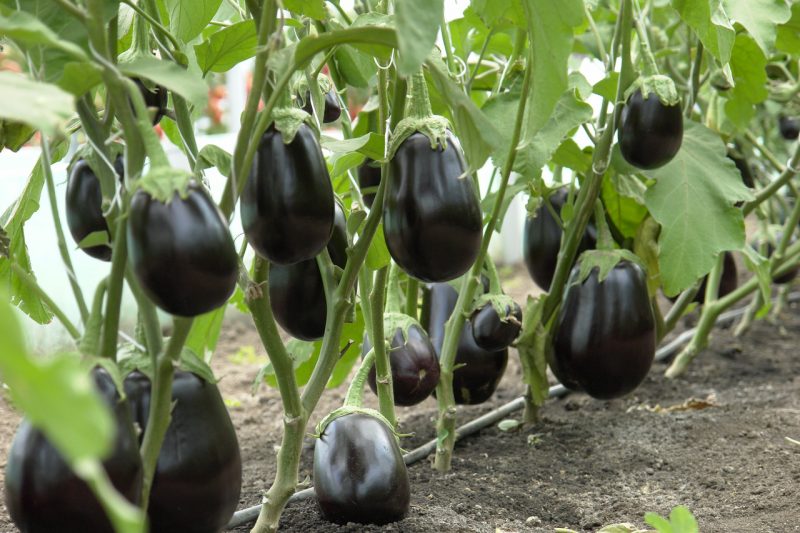
The cause of a bad ovary can be:
- Bad soil
- adverse climatic conditions (cold, little sun);
- improper watering;
- lack of top dressing.
Diseases, pests and methods of dealing with them
Like any other plants in the garden, eggplants can be harmful to diseases and pests, which will significantly reduce yield. To prevent this from happening, the culture must be protected from pests and prevented from diseases.
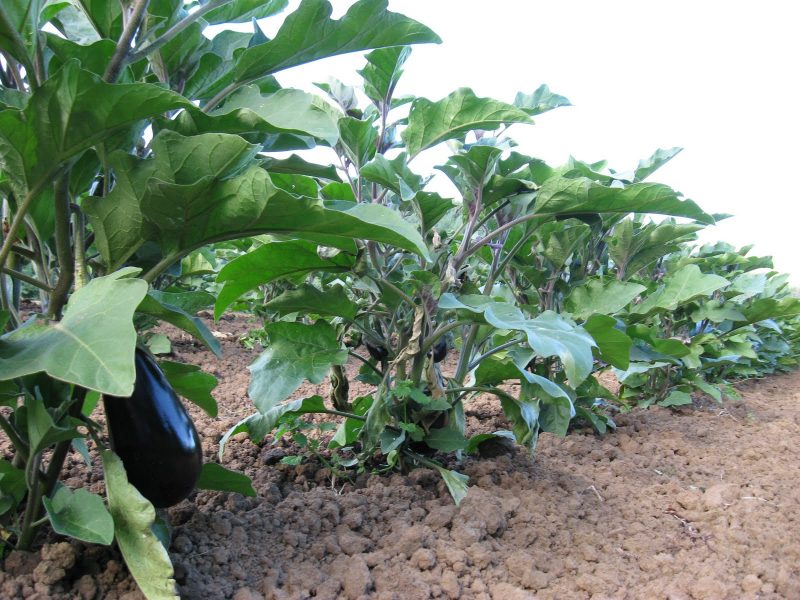
Eggplant, planted in open ground, is often subjected to such ailment as columnar. This is a viral disease that cannot be treated. The first symptoms are thickening of the stem, deformation and falling of damaged leaves. Preventive control methods: getting rid of weeds, aphids, proper watering and loosening.
A pest called tobacco thrips living in plant debris also poses a threat to plants by sucking moisture out of them. As a result, the leaves turn yellow and fall off. In order to prevent thrips from appearing on the site, it is necessary to dig up the soil in the fall, to prevent the growth of weeds, to disinfect the soil, to spray the leaves with water tincture of red pepper.
Very often eggplants are invaded by aphids and slugs. In this case, the plants can be sprayed with the “Strela” preparation, which is harmless to humans.
Not averse to eating eggplant whiteflies, bears and, of course, Colorado beetles. Ways to get rid of these pests diverge from alternative methods to chemicals.
Eggplant collection and storage
For best storage, it is recommended that eggplant fruits not be allowed to fully mature. Harvesting is carried out after 2-3 days due to uneven maturation. Take off the fruit with the stalk. Eggplants are stored in open plastic bags or in boxes, while they are wrapped in paper or sprinkled with straw. Harvested containers are placed in a dark, cool place. Under such conditions, the fruits can be stored for up to 3 months.
It is interesting:eggplant - growing and care
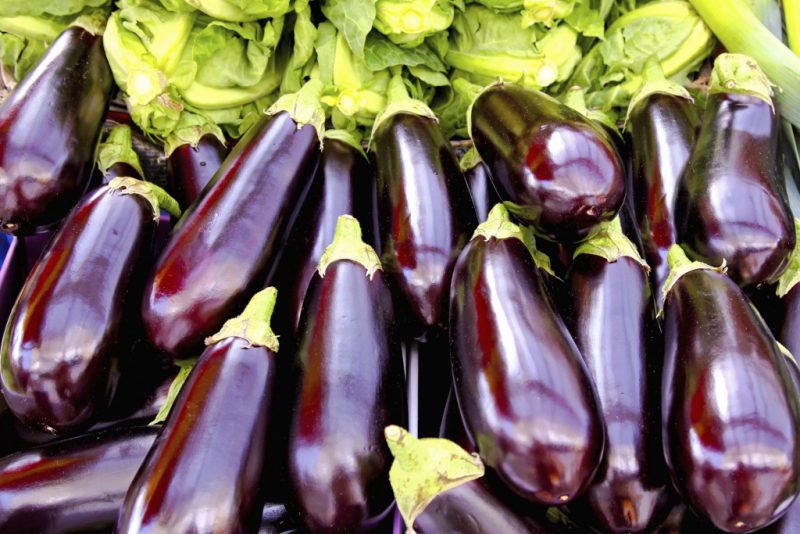
Observing all the rules and recommendations for cultivation and care, in the end you can enjoy a good and high-quality eggplant crop.












